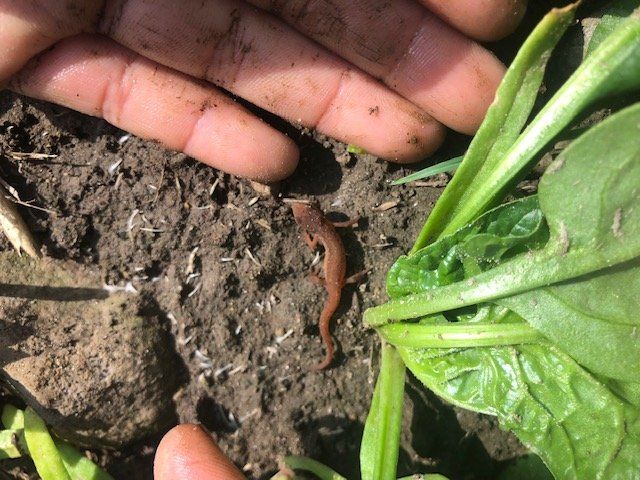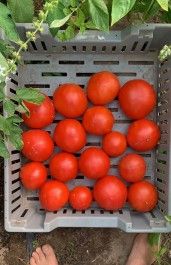August 5, 2021
The Lettuce Rejoice!
Firmly Rooted Farm's Newsletter for their Veggie Loving Farm-ily

On the Farm: Tomato, Tomahto
Hello again my veggie loving friends,
On the farm, we are busy harvesting, planting, weeding, washing, pruning, and completing all sorts of odd jobs, as per usual. It’s around this time we really get into our stride; new crew members are well trained, systems have been perfected, and everyone understands the “feel” of the farm. I’m constantly inspired by the work ethic, ingenuity, and curiosity of those I work with. It’s truly a joy to be around them every day.
Another joy to be had; it is tomato season, the most wonderful time of the year! These plump little balls of juicy deliciousness are reaching peak production. I absolutely devour tomato salads this time of year. Fresh tomatoes are a vegetable rivalled by none in my books. But are they vegetables or fruit? The US Supreme Court went so far as to declare the tomato a vegetable (for tax purposes) but science would have to disagree. The tomato is a fruit, a berry specifically, and vegetables do not exist (unless you look at things from a purely culinary perspective).
Following the trend of exploring food and plant history, I was curious about the history of the tomato. And boy, is it rife with controversy. But first, let us explore its humble beginnings. The tomato originates from the time of the Aztecs in Mesoamerica. The name “tomato” comes from the Nahuatl word “tomatl”. The Aztecs domesticated the fruit from a wild relative as early as 700 CE, although exact dates are unknown. Spanish conquistadors introduced seeds of the tomato to southern Europe during the early 16th century, where they were first grown ornamentally and eventually adopted as a food source (especially with the invention of pizza in Naples around 1880).
The controversy surrounding the tomato surprisingly has to do with witchcraft. Between 1300 and 1650, many Europeans, mainly women, were executed for allegedly practising witchcraft. When tomatoes were first imported to Europe, witch hunters were attempting to discern the contents of “flying ointment”; goo witches smeared on their broomsticks to give the objects magical properties. I swear I’m not making this up, this actually happened. This special goo could also apparently transform the witch into a werewolf, the form preferred for attacking small children (from only the left side for some reason), and to stalk through cursed cropland. The key ingredients were determined to be hemlock, nightshade, henbane, and mandrake. Why does this matter in the case of tomatoes? Well, the last three are the tomato’s closest botanical relatives. People's fear of the unknown and fear of witches overlapped, stoking fear of the tomato as well. Whether or not this ointment existed at all is contestable, but regardless, the witch hunt was a crazed and state-sanctioned event and fear surrounding the existence of witches and their association with the devil was very real and very damaging (it’s estimated that as many as 500,000 people died as a result of the witch hunts).
Scientists of the time did not help quell the fear of the tomato either. The tomato became associated with fruit in an ancient text from a Greek physician named Galen, who described something called a “wolfpeach” as a poisonous Egyptian plant. Given the witchfinders’ werewolf goo assumptions and the name of the wolfpeach, botanists wondered if they were the same plant and classified the tomato and the wolfpeach as one and the same. This was controversial for two reasons; evidently, the tomato was edible, as the Aztecs and many in the Mediterranean were already enjoying its delectable taste, and the plant could not have originated from Egypt as well as Mesoamerica. Through a series of reclassifications, which did not do much to stamp out the negative image of the tomato, the English came to regard the tomato as gross and maybe satanic. These assumptions were transported to the United States and other colonies as well. You can read more about the magical history of the tomato here if you’re curious.
Even as recently as the 1850s, a Harvard-trained doctor can be cited as blaming the tomato for bleeding gums to hemorrhoids. Although by this time, tomatoes had become far more popularly eaten, with famous enjoyers such as Thomas Jefferson working to popularize the fruit.
Honestly, the historical association with witchcraft lends itself nicely to the image of the tomato in my mind. How ridiculous and awesome is it that the lowly tomato was once so widely feared for reasons of blasphemy. Truly a testament to the human tendency to fear change, despite it being such a constant in our lives. At Firmly Rooted we love eating and growing tomatoes. This year we are not growing heirlooms, simply because they are too unpredictable. They don’t store well in transport and don’t hold up as well on the plant either. We are disappointed every time we have to throw out heirlooms. But are happy to focus our efforts on popular non-heirloom varieties, which hold beautiful flavours as well.
Kitchen Corner

I eat calabrese salads on the regular in the summer. Cheese, tomato, basil, are just a few of my favourite things. Sometimes I add a little balsamic vinegar to compliment the richness of the cheese. But of course, there are so many good ways to enjoy tomatoes this time of year. You can eat them in a Greek salad, put them on pizza, make fresh pasta sauce, can them, dry them, you name it. The witch-fearing Europeans were truly missing out on something incredible.
Kitchen Clean Up
If you are picking up your veggies on the farm and have tomatoes in your share be sure to grab them from the table outside the cooler. We've highlighted your label if you've ordered tomatoes, but we don't add them directly into the share because cold tomatoes taste gross.
That’s all for now folks, happy eating until next time!
Farmer Erika




